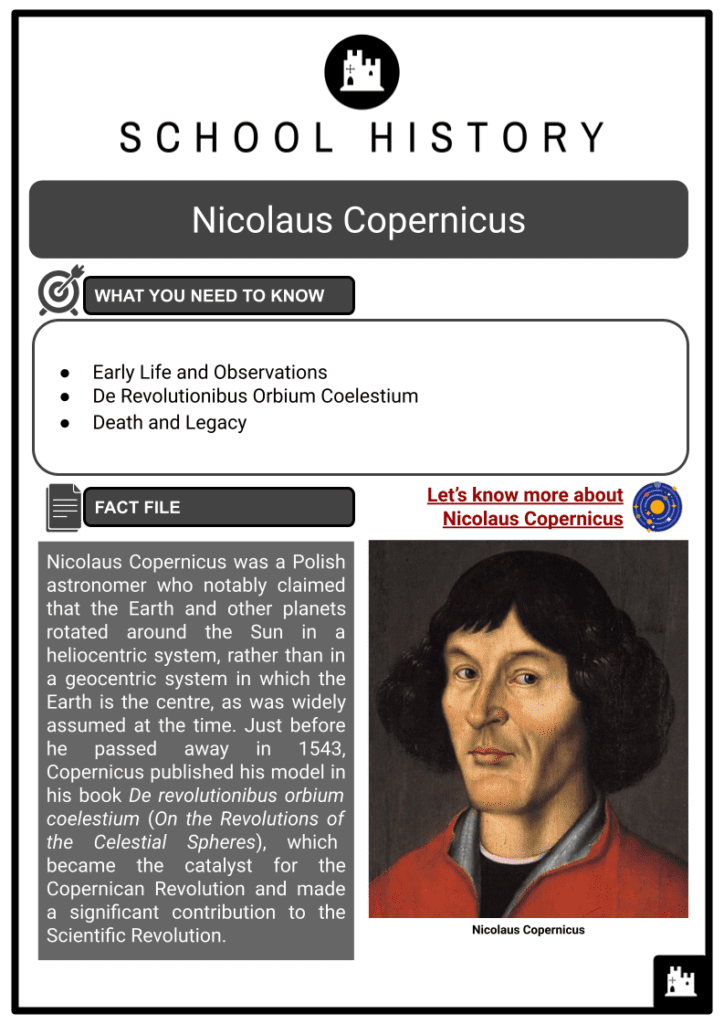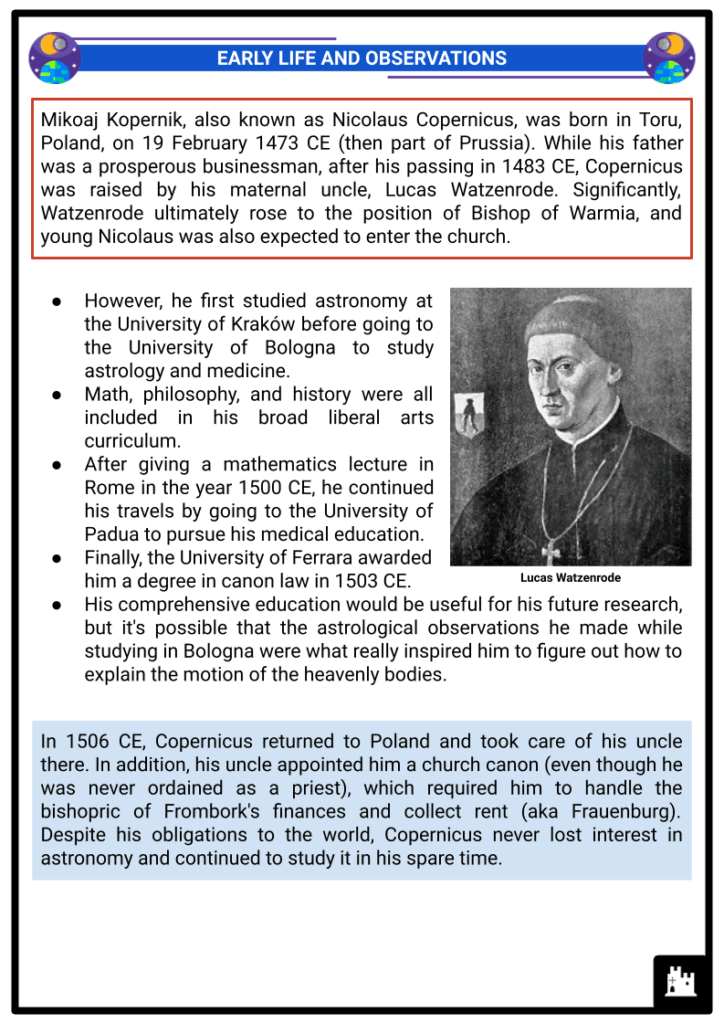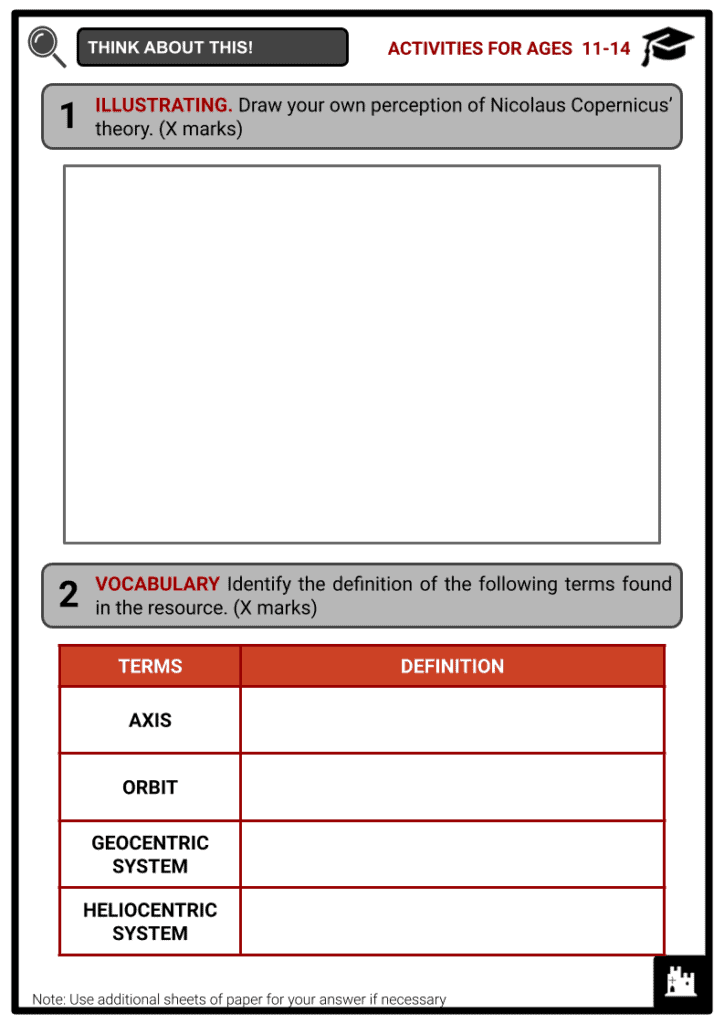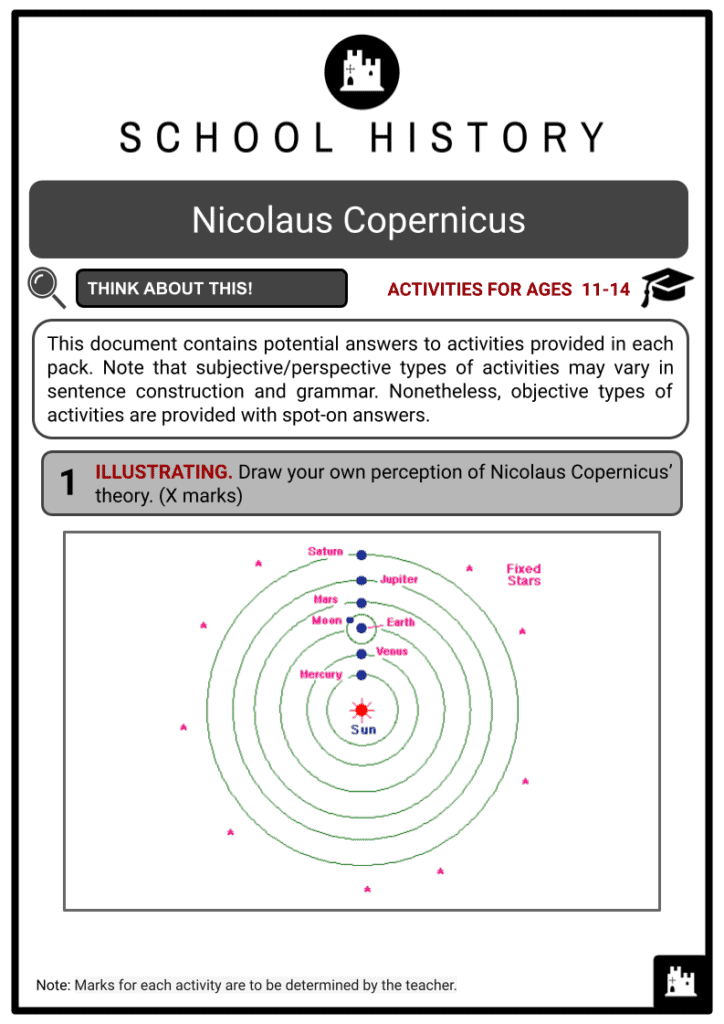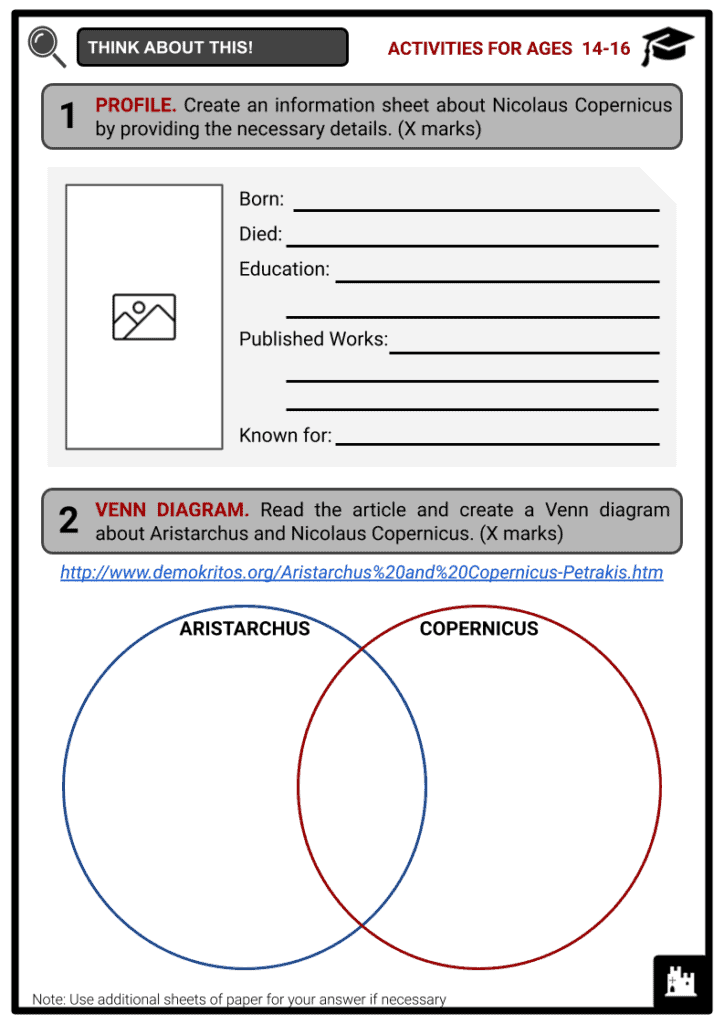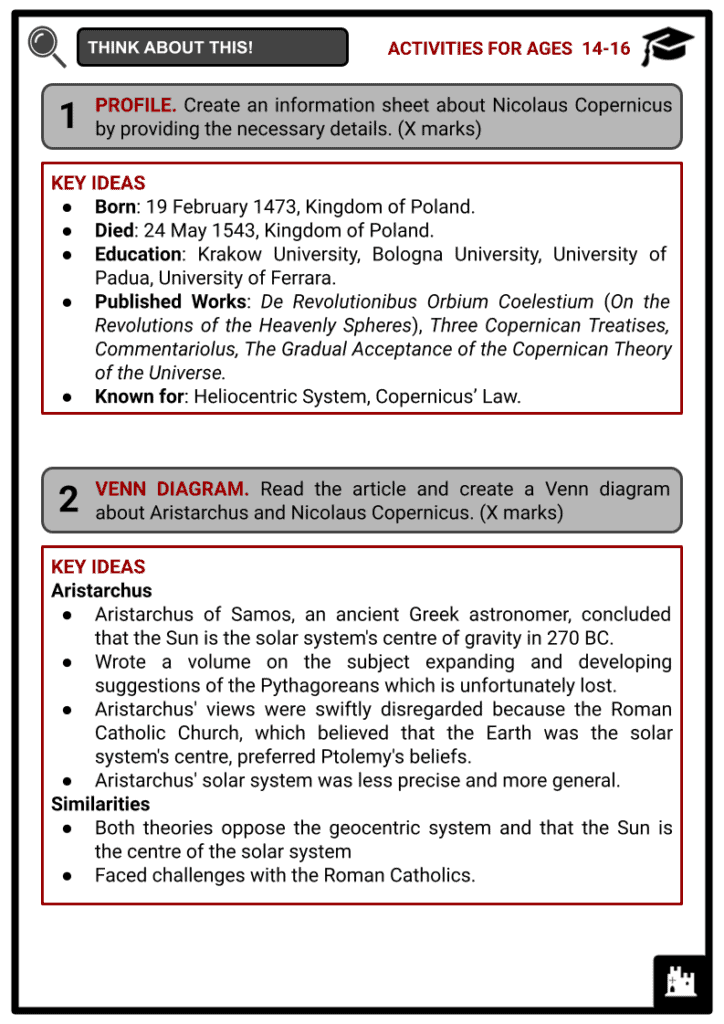Nicolaus Copernicus Worksheets
Do you want to save dozens of hours in time? Get your evenings and weekends back? Be able to teach about Nicolaus Copernicus to your students?
Our worksheet bundle includes a fact file and printable worksheets and student activities. Perfect for both the classroom and homeschooling!
Summary
- Early Life and Observations
- De Revolutionibus Orbium Coelestium
- Death and Legacy
Key Facts And Information
Let’s find out more about Nicolaus Copernicus!
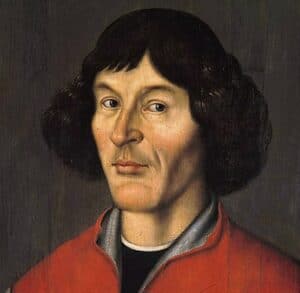
Nicolaus Copernicus was a Polish astronomer who notably claimed that the Earth and other planets rotated around the Sun in a heliocentric system, rather than in a geocentric system in which the Earth is the centre, as was widely assumed at the time. Just before he passed away in 1543, Copernicus published his model in his book De revolutionibus orbium coelestium (On the Revolutions of the Celestial Spheres), which became the catalyst for the Copernican Revolution and made a significant contribution to the Scientific Revolution.
EARLY LIFE AND OBSERVATIONS
- Mikoaj Kopernik, also known as Nicolaus Copernicus, was born in Toru, Poland, on 19 February 1473 CE (then part of Prussia). While his father was a prosperous businessman, after his passing in 1483 CE, Copernicus was raised by his maternal uncle, Lucas Watzenrode. Significantly, Watzenrode ultimately rose to the position of Bishop of Warmia, and young Nicolaus was also expected to enter the church.
- However, he first studied astronomy at the University of Kraków before going to the University of Bologna to study astrology and medicine.
- Math, philosophy, and history were all included in his broad liberal arts curriculum.
- After giving a mathematics lecture in Rome in the year 1500 CE, he continued his travels by going to the University of Padua to pursue his medical education.
- Finally, the University of Ferrara awarded him a degree in canon law in 1503 CE.
- His comprehensive education would be useful for his future research, but it's possible that the astrological observations he made while studying in Bologna were what really inspired him to figure out how to explain the motion of the heavenly bodies.
- In 1506 CE, Copernicus returned to Poland and took care of his uncle there. In addition, his uncle appointed him a church canon (even though he was never ordained as a priest), which required him to handle the bishopric of Frombork's finances and collect rent (aka Frauenburg). Despite his obligations to the world, Copernicus never lost interest in astronomy and continued to study it in his spare time.
- Copernicus had to face a number of issues during his investigation of the cosmos, which caused disagreement among astronomers. There was the lasting concept, put forth by Aristotle, that the planets travelled uniformly through an ill-defined medium of invisible spheres, always at fixed distances from the Earth, the centre of the universe. As a result, the cosmos must consist of a collection of spheres that are positioned in a series. Unfortunately, observing a variation in the brightness of planets in the night sky did not support this notion.
- Another long-standing and related issue arose on the subject, this time the result of Claudius Ptolemy's theories. Ptolemy believed that planets followed a greater orbit (deferent) around a fixed central point, the Earth (equant), or, in Ptolemy's case, a point slightly off of it, while also moving within a smaller circular orbit of their own (epicycle). The issue with this theory was that it challenged the conventional wisdom that planets orbited the Earth in a circular motion, moving uniformly and at a constant distance from it.
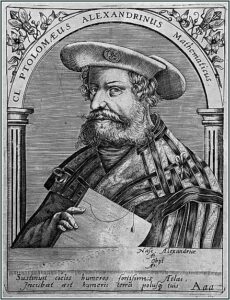
Ptolemy - Combining Ptolemy's orbits within orbits and Aristotle's concentric spheres would cause the planet-containing spheres to wobble and eventually crash, which is not possible in an ordered cosmos.
- Persian astronomers made an attempt to resolve this puzzle in the 13th century CE by joining two epicycles that uniformly revolved around one another.
- This would result in an oscillating point and explain why the distances between planets and Earth altered through time.
- Copernicus was aware of and examined all of these theories, but their intricacy appeared to be an attempt to justify a potentially flawed original model.
- Change the centre equant point, and the theory that explained the behaviour of the planets may become much clearer and simpler.
DE REVOLUTIONUBIS ORBIUM COELESTIUM
- Copernicus spent three decades developing his beliefs about the relationship between the Earth and the celestial bodies that could be seen in the night sky. Although the telescope was not yet invented, he finally developed an explanation for what he saw by watching lunar eclipses and the motion of planets and constellations, around 1514 CE. Copernicus also made extensive use of earlier astronomers' observations, some of which were not entirely correct.
- The invitation for Copernicus to attend the Fifth Lateran Council in 1514 CE is proof that he was engaged and well-respected in the field of astronomy. He went there to express his opinions regarding the proposed changes to the calendar, which are crucial for Church holidays but are now far from in line with the Sun's position on any given day. The renowned astronomer never showed up, though.
- The conclusion of his research was nothing short of mind-blowing for the European academic community, particularly for the hierarchy of the Catholic Church.
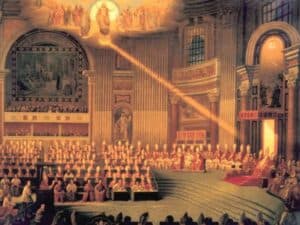
Fifth Lateran Council - Copernicus proposed that the Earth, with all other bodies spinning around it, was not the centre of the universe. Instead, the Sun, the true centre of our solar system, orbited around a planet called Earth.
- The Earth revolving on its axis and orbiting the Sun explained how the celestial bodies moved across the sky in a single night and over the course of a year, and why Mars, Venus, and the stars did not revolve around the Earth.
- Moreover, Copernicus proposed that the Earth rotated once on its axis in a single day and took a year to orbit the Sun. Additionally, the precession of the equinoxes, or the gradual shifting of the constellations in the night sky over time, a phenomenon known since antiquity, was explained by very slight changes in the angle of the Earth's axis over time.
- Because they orbited within the Earth's orbit of the Sun, visible planets like Mercury and Venus displayed just a slight motion in the night sky. Mars, Jupiter, and Saturn's frequently odd motion could also now be attributed to their positions outside of Earth's orbit, where they rotated around the Sun more slowly. Thus, Copernicus was able to demonstrate that the then-observable planets were Mercury, Venus, Earth, Mars, Jupiter, and Saturn, in that order of distance from the Sun.
- Copernicus' six-volume book De Revolutionibus Orbium Coelestium (On the Revolutions of the Heavenly Spheres), which wasn't published until 1543 CE, contained all these revolutionary insights. The author may have been waiting because he was worried about how the public would react, but it is much more likely that he was still struggling with the mathematical details and issues.
- In fact, Copernicus acknowledged that his work was written for mathematicians and that few people outside the field would have understood it. It appears the author tried to minimise the focus on the real world and concentrate on theoretical mathematics by changing the original title from Spheres of the World to Heavenly Spheres.
- But there were still a lot of issues to resolve. The predominant explanation for the observable phenomena of gravity—that objects fell to the earth because the Earth was at the centre of the universe—had been replaced by Copernicus' idea. Copernicus' continued lack of information on the fact that planetary orbits were not perfect circles was another issue. Johannes Kepler, a German astronomer, later proposed that the orbits were elliptical.
- Nicolaus Copernicus published a list of seven axioms (establishments) concerning the universe in 1514. Technically, modern astronomy was founded on these seven assumptions.
- There is no one centre in the universe.
- The Earth's centre is not the centre of the universe.
- The centre of the universe is near the Sun.
- The distance from the Earth to the Sun is imperceptible compared with the distance to the stars.
- The rotation of the Earth accounts for the apparent daily rotation of the stars.
- The apparent annual cycle of motion of the Sun is caused by the Earth revolving around it.
- The apparent retrograde motion of the planets is caused by the motion of the Earth from which one observes.
- Copernicus' theories completely contradicted the traditional concept of humanity's place in the universe as presented by the Catholic Church, which was much more troubling than these physics-related issues. The anthropocentric model, which held that the Sun and Moon revolve around the Earth as its centre, was consistent with the notion that God created humans to be the universe's primary focus and its ultimate purpose. It was challenging to overcome the notion that the Earth was the centre of the known cosmos because it dates back to antiquity (even if some ancient thinkers had proposed a heliocentric system).
- Andreas Osiander, the Lutheran minister who oversaw the publication of De Revolutionibus, had inserted a preface that stated the work was intended as a theoretical aid to mathematicians and not a presentation of how the universe was, which was fortunate for Copernicus even though it took place without his permission.
- This point of view was appropriate for the period because mathematics and astronomy were seen as theoretical topics.
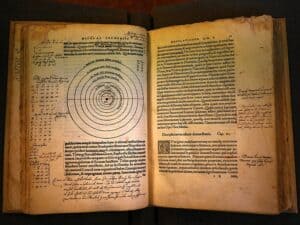
Planetary Orbits in the Book - As changing the popular perception of the physical world was once thought to be the responsibility of natural philosophy, works like the De Revolutionibus could not genuinely seek to do so.
- The preface and the customary division of academic subjects at the time may have protected the work and Copernicus' memory from the full fury of the Catholic Church.
DEATH AND LEGACY
- Copernicus suffered from apoplexy and paralysis around the end of 1542, and on 24 May 1543, he passed away at the age of 70. According to legend, he was given the final printed pages of his De revolutionibus orbium coelestium the day before he passed away, allowing him to say goodbye to his life's work. He reportedly stared at his book after emerging from a stroke-induced coma, before passing away quietly.
- As it turned out, there wasn't much of a response to Copernicus' theory anywhere, and even within the small group of astronomy scholars who were supposed to be its target audience, there wasn't much of a stir. However, it was a slow burner, and a few years after its publication, Copernicus' work came to the fore when succeeding scientists started to examine the same issues and seek ever more precise astronomical tables.
- Martin Luther, a reformist, criticised the De Revolutionibus for being too radical. By 1616 CE, it had gained further notoriety and been labelled a banned book by church authorities who believed it to be heretical.
- Despite attempts by Christianity to ignore Copernicus' findings, his work marked the beginning of a protracted process of scientifically understanding the nature of our solar system and its location in the larger cosmos.
- Great minds like Galileo and Isaac Newton would contribute to the ever-expanding body of knowledge on the motion and characteristics of planets, moons, and stars throughout the succeeding decades.
- Copernicus was one of the main pioneers of the scientific revolution that started during the Renaissance.
- One of the biggest craters on the Moon bears Copernicus' name in recognition of his contributions to modern astronomy and this procedure.
Image Sources
- https://upload.wikimedia.org/wikipedia/commons/thumb/f/f2/Nikolaus_Kopernikus.jpg/440px-Nikolaus_Kopernikus.jpg
- https://upload.wikimedia.org/wikipedia/commons/thumb/1/16/Ptolemy_16century.jpg/440px-Ptolemy_16century.jpg
- https://upload.wikimedia.org/wikipedia/commons/4/43/Lateran-council-5.jpg
- https://commons.wikimedia.org/wiki/File:Nicolai_Copernici_Torinensis_De_revolutionibus_orbium_coelestium.jpg

